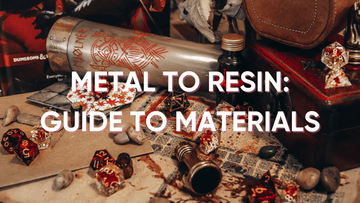Hello, fellow adventurers! Tabletop role-playing games (TRPGs) like Dungeons & Dragons are all about immersion and storytelling. While imagination is the core of these games, physical props can significantly enhance the experience, bringing your game world to life in exciting and tactile ways. Whether you're a seasoned Dungeon Master or a curious player, integrating props into your sessions can make the adventures more memorable and engaging. Here’s how you can use 3D printing, printed handouts, and finds from op shops (thrift stores) to add that extra magic to your game.
1. 3D Printing: Crafting the Fantasy
3D printing is a fantastic tool for creating custom game props, miniatures, and terrain. If you don’t have easy access to a printer, talk to your local library or explore online options (such as Etsy printing services) to get your hands on some printed goodies. With the power of 3D printing, you can greatly enhance your game with:
- Custom Miniatures: There are many online platforms where you can design or purchase 3D models of characters, monsters, and creatures. Once printed, these miniatures can be painted and personalised to reflect the unique traits of your game’s characters.
- Terrain and Maps: 3D printing allows you to create detailed terrain pieces, such as buildings, caves, forests, and dungeons. These pieces can help players visualise complex environments and make tactical decisions during combat.
- Props and Artifacts: You can print replicas of magical items, relics, or significant objects from your campaign. Holding a physical version of a legendary sword or mystical amulet can make players feel more connected to the story.
2. Printed Handouts: Tangible Story Elements
Printed handouts are an effective and inexpensive way to deepen the immersion in your game. With a quick search online, you will find that many other creative players have already prepared options for you to make use of. Here are some ideas:
- Letters and Maps: Create letters, maps, or official documents that players can physically handle. Use parchment-style paper or add decorative elements like seals or wax stamps to enhance authenticity. These can serve as clues, lore pieces, or mission briefings.
- Visual Aids: Print images of characters, monsters, or locations to help players visualise the world. This is especially useful for introducing new NPCs or describing fantastical creatures.
- Puzzle Elements: Include puzzles or riddles on your handouts that players must solve to progress in the game. This can add a fun and interactive element to the session, encouraging teamwork and critical thinking.
3. Shop for Hidden Treasures
Op shops, garage sales, and markets are treasure troves of potential game props. Keep an eye out as you’re out and about for interesting pieces that can add depth to your storytelling. Here’s how to make the most of your finds:
- Costume Pieces: Look for jewellery, hats, cloaks, or other items that can be used to represent magical artifacts or character costumes. Even simple items can add a lot to the role-playing experience.
- Old Books and Trinkets: Antique books can serve as spellbooks,grimoires, or ancient tomes in your game. Decorative jars, bottles, boxes, figurines, or old keys can also become relics or magical items.
- Whimsical Decor: Small furniture pieces or decor items, like candle holders or vintage maps, can be used to set the scene, whether you’re playing in person or streaming your game online.
4. Recycle from Board Games
Board games often include coins or tokens to represent currency, points, or resources. These can be seamlessly integrated into your RPG as in-game money or special tokens:
- Using Board Game Coins: Coins from games like Monopoly, Catan, or Pirate-themed games can be used as fantasy currency or treasure. They are usually colour-coded or shaped distinctively, making it easy to designate different values or types of currency (e.g., gold, silver, bronze).
- Resource Management: Counters can also represent various resources like food, water, ammunition, or mana. This can add a layer of resource management to your game, making survival elements more tangible.
- Miniatures and Stand-ins: Some games come with small figurines or standees that can be used as miniatures for player characters or NPCs. Even if they aren't perfectly detailed, they can help players visualise the action and add a tactile element to the game.
5. Integrating Props into Gameplay
Now that you have your hands on some interesting props, what’s the best way to make use of them? Here are some tips for seamlessly integrating props into your TRPG sessions:
- Keep It Relevant: Ensure that props enhance the story rather than distract from it. They should add to the immersion and be relevant to the plot or setting.
- Use Sparingly: Overusing props can overwhelm players. Use them sparingly to highlight important items, moments, or details.
- Encourage Interaction: Allow players to interact with the props. Let them examine a handout, pass around a miniature, or try on a piece of jewellery. Physical interaction can deepen engagement and make the game more memorable.
- Prepare in Advance: Prepare your props before the session. Ensure everything is ready to go and easily accessible when needed.
Integrating physical props into your tabletop role-playing games can significantly enhance the storytelling and immersion of your sessions. Whether you're using 3D-printed miniatures, printed handouts, thrift store treasures, or recycled board games, these props can bring your game world to life in new and exciting ways. So, unleash your creativity, and let your players experience the magic of a fully immersive TRPG adventure!






